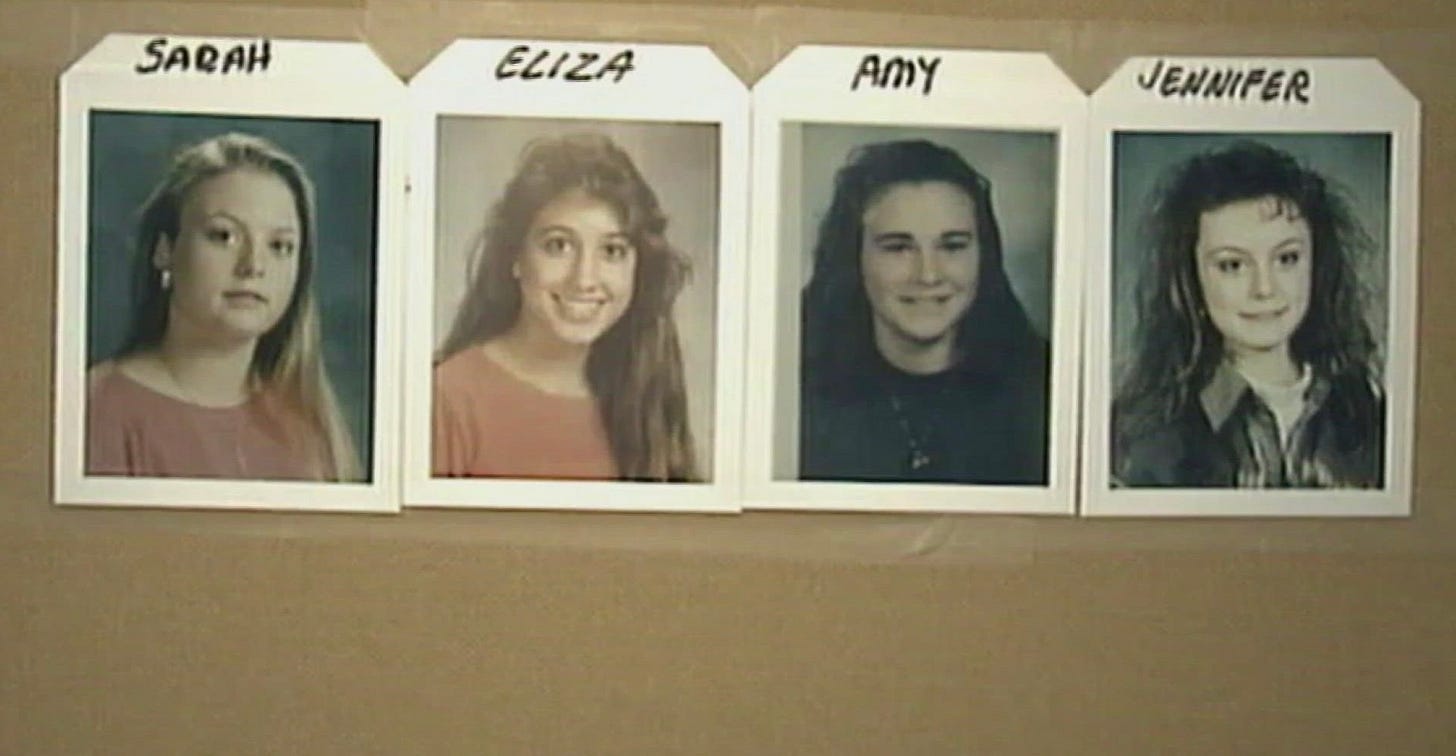Yogurt Shop Murders: An Unsolved Cold Case
🔥 The Yogurt Shop Murders: Austin’s Cold Case That Still Haunts Decades Later
On the night of December 6, 1991, Austin, Texas, lost its innocence. Four teenage girls—Jennifer Harbison, 17, her sister Sarah, 15, their friend Eliza Thomas, 17, and Amy Ayers, just 13—were brutally murdered inside an “I Can’t Believe It’s Yogurt!” shop. What was supposed to be an ordinary Friday night ended in unimaginable horror, sparking one of the most infamous unsolved cold cases in Texas history.
More than three decades later, the case—known as the Yogurt Shop Murders—remains unsolved. 🚨 Despite multiple arrests, high-profile trials, overturned convictions, and modern DNA testing, the families of the four victims are still waiting for justice.
This is their story.
🌙 The Night of December 6, 1991
It was a typical cool evening in Austin. The yogurt shop was closing for the night. Jennifer and Eliza, both employees, were working the final shift. Sarah and Amy had joined them, simply planning to hang out before heading home.
At some point between 10 p.m. and midnight, unknown intruders entered the shop. What happened next was so brutal that first responders would never forget it.
A fire was deliberately set to destroy evidence. When firefighters arrived, they made a chilling discovery: the bound and stacked bodies of the four girls. Each had been shot in the head. The flames had consumed much of the evidence, but the horror of the crime scene spoke volumes.
Austin was forever changed. 💔
👮 The Investigation Begins
Detectives immediately knew they were facing a nightmare. The fire had wiped away potential fingerprints and DNA. Leads were scarce, and pressure from the public and the media was immense.
Hundreds of people were interviewed. Rumors swirled. Theories ranged from a robbery gone wrong to a possible serial predator targeting young women.
But despite relentless effort, the investigation dragged on without clear suspects.
The city held vigils. Families pleaded for answers. The Yogurt Shop Murders became a case everyone in Austin knew about, but nobody could solve. 🕯️
🔒 The Wrong Suspects
By the late 1990s, nearly eight years later, detectives zeroed in on a group of young men who had once hung around the area:
Michael Scott
Robert Springsteen
Maurice Pierce
Forrest Welborn
What followed would become one of the most controversial chapters of the case.
After intense interrogations, Michael Scott and Robert Springsteen confessed. But their confessions were riddled with inconsistencies. They contradicted one another and, most importantly, they did not match the physical evidence.
Still, prosecutors pressed forward.
In 2001, Springsteen was convicted and sentenced to death. ⚖️
In 2002, Scott was convicted and sentenced to life in prison.
For a moment, it seemed justice had been served. But cracks soon began to appear.
🧬 DNA Breakthroughs
As forensic science advanced, investigators tested preserved evidence with modern DNA technology. The results were shocking:
👉 The DNA found at the crime scene did not match Scott, Springsteen, Pierce, or Welborn.
The cornerstone of the state’s case—the confessions—was collapsing under the weight of science. Experts began to argue the confessions had been coerced, the product of psychological pressure during long interrogations.
In 2006, Springsteen’s conviction was overturned.
In 2009, Scott’s conviction was overturned.
Both men were released.
The families, who had endured years of court proceedings, were devastated. Once again, the murders of their daughters were unsolved.
🕵️ The Lingering Unknown
Today, the Yogurt Shop Murders remain an open case. The unknown male DNA profile still haunts investigators, a ghost in the evidence pointing toward someone yet to be identified.
Cold case detectives continue to revisit the files, hoping advancements in forensic genealogy—the same technique that solved the Golden State Killer case—may one day reveal the truth.
For the families, time has not healed the wounds. The pain remains raw. They continue to speak out, ensuring the names of Jennifer, Sarah, Eliza, and Amy are never forgotten. 🌹
📰 Why This Case Still Matters
The Yogurt Shop Murders highlight deep flaws in the justice system:
The dangers of relying on coerced confessions 😔
The fragility of evidence when fire is used to destroy it 🔥
The emotional toll of wrongful convictions ⚖️
The resilience of families who refuse to stop fighting 💪
It also serves as a stark reminder that unsolved cases are not “cold” to those who live with their consequences every single day.
🕯️ Remembering the Victims
At the heart of this story are four young girls whose lives were stolen:
✨ Jennifer Harbison (17) – a bright, responsible teen with a love of animals and dreams for the future.
✨ Sarah Harbison (15) – Jennifer’s younger sister, known for her smile and kindness.
✨ Eliza Thomas (17) – hardworking, friendly, and beloved by her friends and family.
✨ Amy Ayers (13) – the youngest, full of life and curiosity, taken before she even had a chance to grow up.
Their memories live on in the hearts of their families and in the fight for justice.
💔 A Case That Demands Answers
More than 30 years later, the Yogurt Shop Murders remain one of the darkest chapters in Austin’s history. The case is a blend of tragedy, controversy, and hope—a reminder of both the failures and the possibilities of our justice system.
For the families, closure has never come. For investigators, the search for truth continues. And for Austin, the memory of that December night in 1991 is something the city can never forget.
Until the killers are identified, this remains an open wound—a cold case that still burns hot in the hearts of all who remember the four girls whose lives ended far too soon. 🌹🕯️



